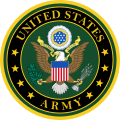| Sixth Army | |
|---|---|
 | |
| Active | 1924-1933 1943–1995 2008–present |
| Country | |
| Allegiance | United States of America |
| Branch | |
| Type | Theater Army |
| Role | Component command |
| Garrison/HQ | Fort Sam Houston, Texas |
| Nickname | "Alamo Force" |
| Motto | Born of War |
| Engagements | World War II |
| Decorations | Meritorious Unit Commendation Superior Unit Award [1] Philippine Republic Presidential Unit Citation |
| Website | arsouth.army.mil |
| Commanders | |
| Notable commanders | Walter Krueger Joseph Stilwell Albert C. Wedemeyer Robert M. Cannon David E. Grange Jr. William Hardin Harrison |
| Insignia | |
| Flag |  |
| Distinctive unit insignia |  |
| Sixth Army's Shoulder Sleeve Insignia 1927-1945 Saw limited use in WW2 |  |
| Sixth Army's Shoulder Sleeve Insignia during WW2 until the 1950s |  |
| NATO Map Symbol |  |
Sixth Army is a theater army of the United States Army. The Army service component command of United States Southern Command, its area of responsibility includes 31 countries and 15 areas of special sovereignty in Central and South America and the Caribbean. It is headquartered at Fort Sam Houston.
Contents
- History
- Interwar period
- World War II
- Reactivation
- Decorations
- Commanding officers
- References
- External links
The Sixth Army saw extensive service in the South Pacific during World War II, including in New Britain, New Guinea, and the Philippines. Postwar it served stateside training army forces until its inactivation during force reduction in 1995. The army was reactivated in 2007.
